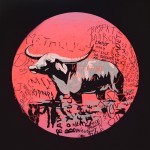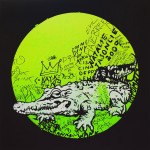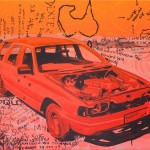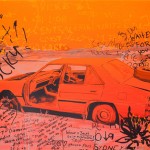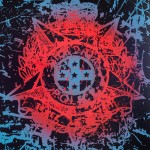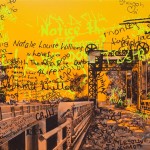Canberra Contemporary Art Centre, 2010
Outback Explorer
James Dodd
The outback has had many guises in Australian folklore, mythology and contemporary culture. These have been discussed ad infinitum so I won’t bore you with another variation of the part heroic frontier, part unforgiving embodiment of terror, part red hearted siren stereotypes – I’ll just cut to the chase. I like it out there. I like thinking about it in all its potentials and I like making art about it.
Graffiti is hardly the first thing that springs to mind when considering the outback – especially when the majority of contemporary society has forgotten what ‘graffiti’ actually is. Graffiti to me is not displaced hoodlums clinging to the outside of moving passenger trains creating illegible psychadelic vomit fonts. It is not a Keith Haring drawing in a museum and it is not an Os Gemeos masterpiece diligently wallpapered to the exterior of some Disney-esque European castle. Graffiti, to me, are simple hand-made residues left by individuals in public places. The kind of innocent and nasty statements that have been recurring for centuries such as ‘JD 4 AE’, or ‘Jimmy is an asshole’, is the kind of graffiti that is exciting to me. Graffiti is crude, unresolved and unsolicited and the Australian outback is filled with it.
Graffiti such as these are representative of individuals and groups of people, their thoughts, motivations and emotions. In this way we can examine the psyche of a place via its public inscriptions. The collations presented in this exhibition offer us an insight into the people that inhabit or are passing through our contemporary outback. Just as Rennie Ellis’ collections of Australian graffiti from the seventies and eighties have become an invaluable reference to reflect upon the politics, morality and raw emotion of the time period and places that he documented; so are the graffiti presented here.
I have made many observations of unique elements and nuances specific to regional Australian graffiti that keep me fascinated and motivated to continue to explore and examine the vast tracts of words written on the walls of our nation. These blunt, succinct and often brutal statements keep me entertained via their potential to become containers of rich stories, compressed within the unruly scrawl of variously spirited people. In one way I imagine the creators of these proclamations as noble anti-literary nomads, navigating endless rivers of dusty bitumen, felt-tipped staffs held aloft, reciting foul mouthed mantras, preaching to the ghosts of the road in a never ending ritual of marking, erasure and marking.

